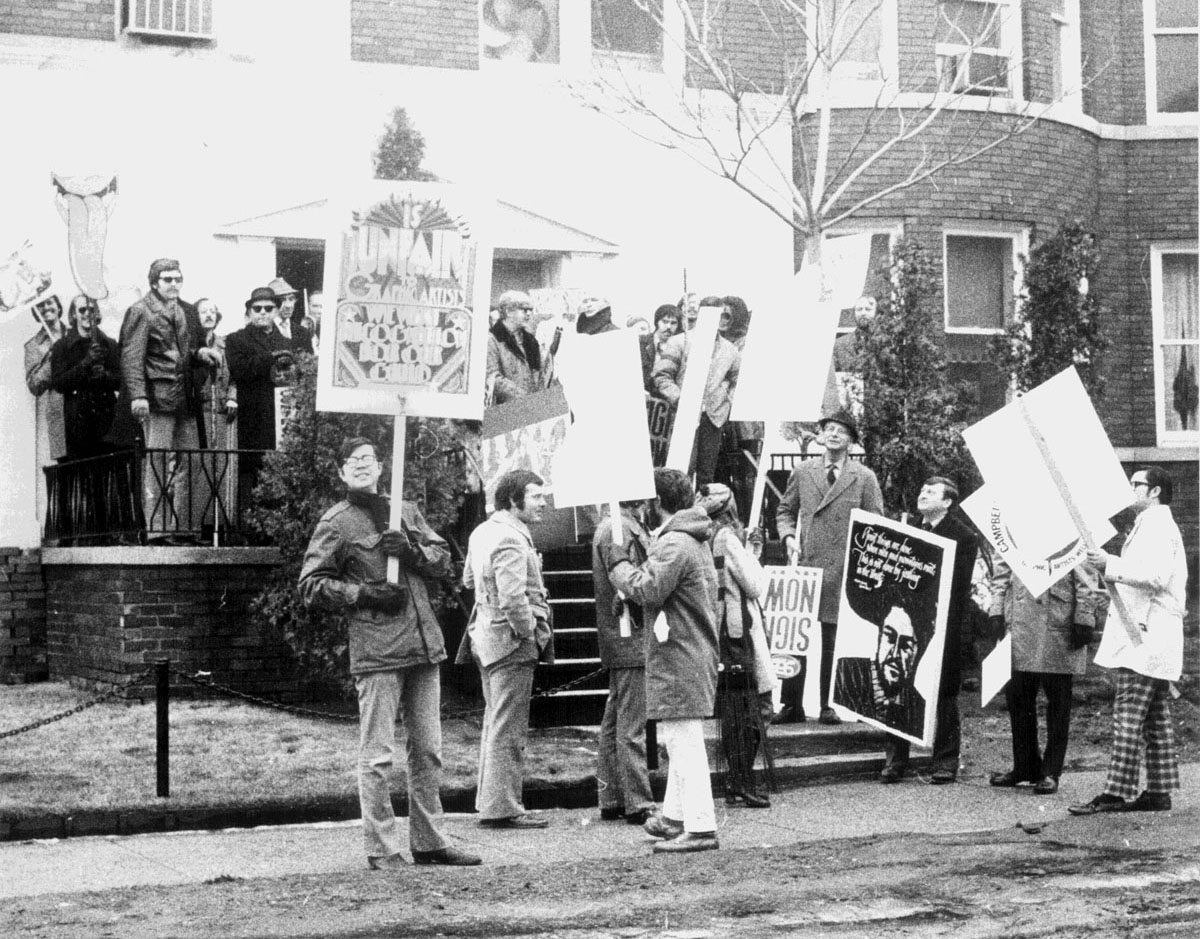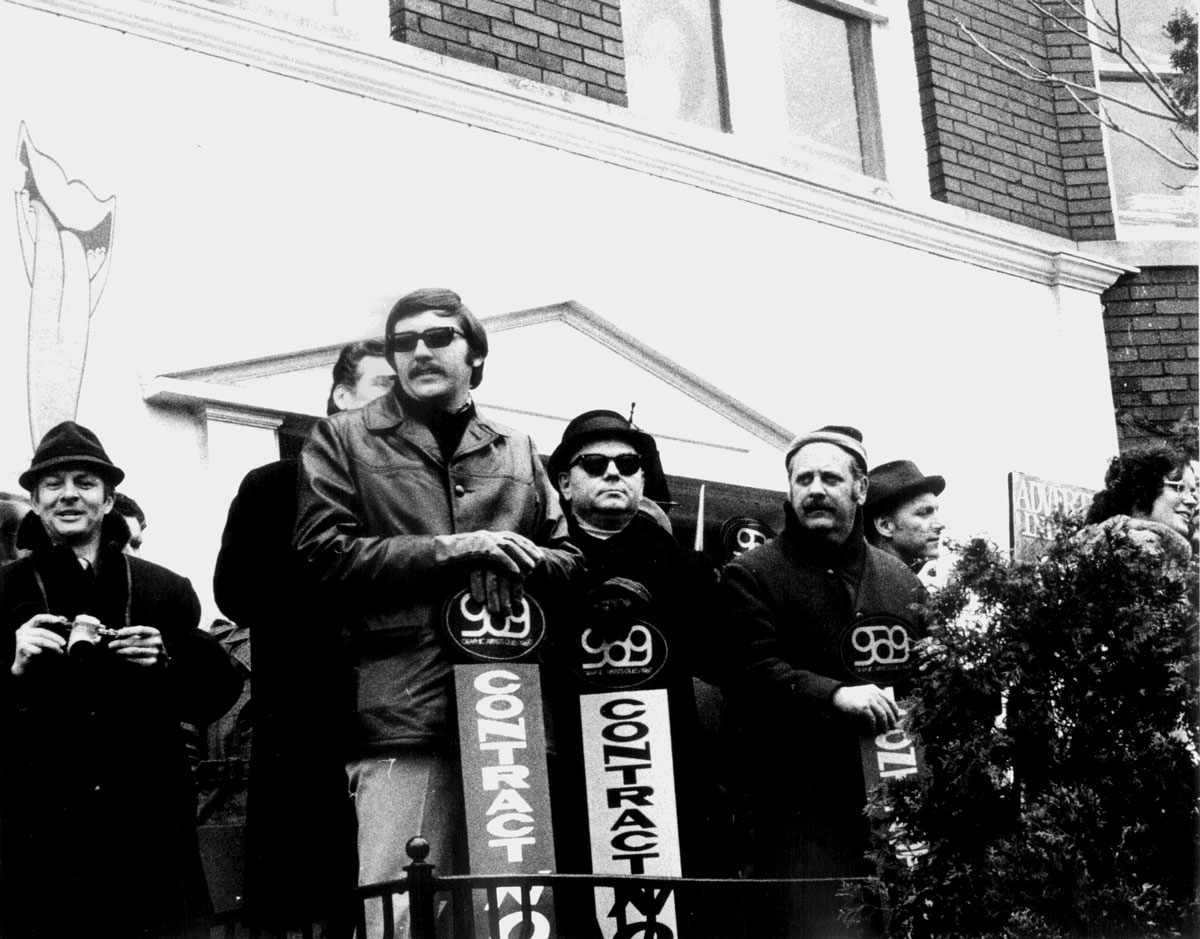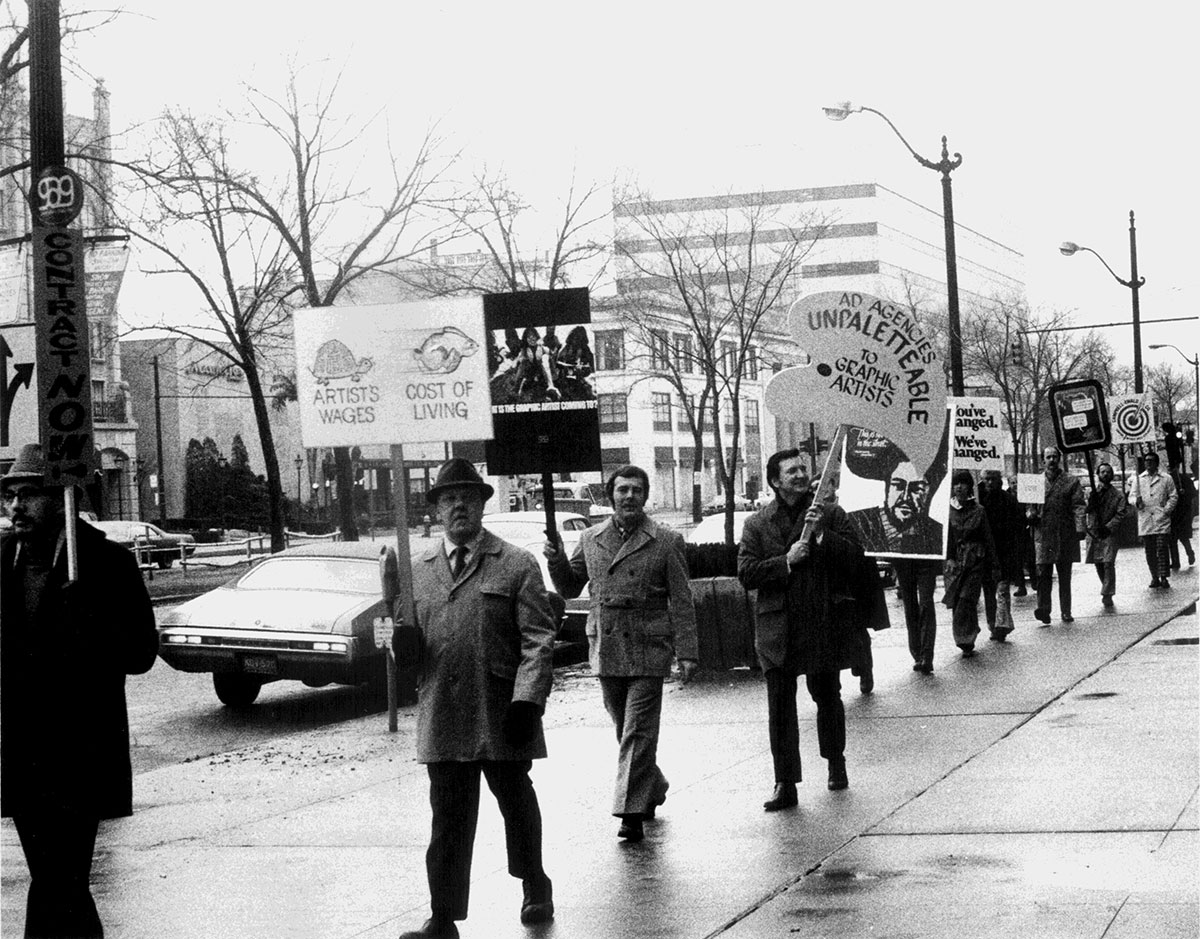
10 Feb Realizing a Dream: The First Thirty Years of the Graphic Artists Guild
By Dan Ballard
In early December, former Guild member Dan Ballard unexpectedly passed away. For many decades, Dan was a fixture in the Seattle artist community, serving on the board of SPGA–Seattle Guild Chapter. A passionate advocate for graphic artists, Dan became the unofficial historian of SPGA and the Graphic Artists Guild. The boxes of Guild ephemera and documentation Dan collected were curated and donated to the Tacoma Public Library by Guild member Mark Monlux. To memorialize Dan’s work as Guild historian, we’re publishing his history of the Graphic Artists Guild, written on the occasion of our thirtieth anniversary.

The fall of 1967… It was the era of the “Summer of Love,” Haight-Ashbury, LBJ in the White House, the Vietnam War in full swing, civil rights marches, The Doors, Jefferson Airplane. Martin Luther King Jr. and Bobby Kennedy were still alive, the Pill, hippies living in communes, NASA still racing to get to the moon. A tumultuous and momentous time, to be sure.
Against this backdrop of moving beyond the status quo, experimentation, and rebellion against “The Man,” a group of graphic artists in Detroit, Michigan, decided that they too had had enough of what was then considered the norm. The Graphic Artists Guild was about to be born.
Today, many in our profession are feeling uncertain and insecure in the face of things like royalty-free and stock-image vendors undercutting us, the digital revolution’s encroachment upon our copyright ownership, and work-for-hire contracts becoming widespread. Yet the working conditions for graphic artists that our predecessors endured 40 years ago were downright draconian by comparison.
In Detroit, the automotive industry was the primary client for most of the commercial artists (designers and illustrators) in the region. By the mid-1960s, a system of ‘art studios’ had developed to service the car-makers and their advertising agencies’ insatiable need for design and imagery. To get auto-industry work, the majority of Detroit’s artists had to go through the art studios, which in turn sold their artists’ work to the ad agencies. Graphic artists who were unwilling to play ball with the studios and agencies were likely not going to get work, at least not from Detroit’s main client base.
As if it weren’t bad enough to have to go through a second party to access most of the choice work opportunities in town, Detroit’s art studio artists were also subjected to oppressive and demeaning working conditions. These practices included:
- Being denied official employee status (or benefits), even while working in-house.
- Getting a weekly check for a set amount (called a salary draw); artists who worked too few hours that week were placed in debt to the studio for the difference in hours (many artists were often living in the red financially, due to this policy).
- Catching hell from their studio bosses if artists had the audacity to freelance on the side.
- Being denied work in the studio they worked at, if they fell into disfavor for some reason (artists were dependent upon the studio’s sales reps to find them work).
This was the unenviable lot of Detroit’s graphic artists in the mid-1960s. This state of affairs did not sit well with one of Detroit’s leading freelance illustrators, Martin C. Anderson.
Known as “Marty” to his friends and colleagues, he was a World War II veteran with a professorial appearance. He lost his left hand during combat in Europe, but this did not deter him from pursuing a career as an illustrator. Prior to establishing himself as a successful freelancer, Marty himself had worked in the studios, so he understood the plight of his fellow graphic artists.
Marty Anderson had a dream—that graphic artists everywhere could and should gain control over their own work and destinies. If workers across the country had succeeded in their efforts to unite and organize, why couldn’t artists do the same? He set out to make that dream a reality, with the help of a small group of his Detroit colleagues. These were the founders of what would eventually be christened, “The Graphic Artists Guild.”
In the year leading up to the fall of 1967, Marty and other founding members met frequently and did extensive research on the labor movement: how unions were structured and how they operated, ethical codes, and what was included in a union’s constitution. Marty met with the President of the UAW and the Executive Secretary of the Screen Actors Guild (SAG) to get their input on forming a labor union for artists. Eventually, the artists settled upon the SAG Constitution as a model upon which to base the first incarnation of the Guild’s Constitution, which Marty authored.
Having established the fledgling group’s basic structure and operational functions, the founders enlisted members from the Detroit region. An initial group of 113 local graphic artists were on board by the time that they made it official, by signing the Guild’s Charter document, on November 2, 1967. The Graphic Artists Guild was now a reality.
Some of the Graphic Artists Guild’s Founding and Charter Members in front of the original Detroit Guild Office (circa 1970). From left to right: First-ever National President Martin Anderson, Board Member Ray Burdzinski, Board Member and 2nd Detroit Chapter President Jerry Campbell, First-ever National Vice-President Lou McMurray, and Charter Member Max Altekruse.
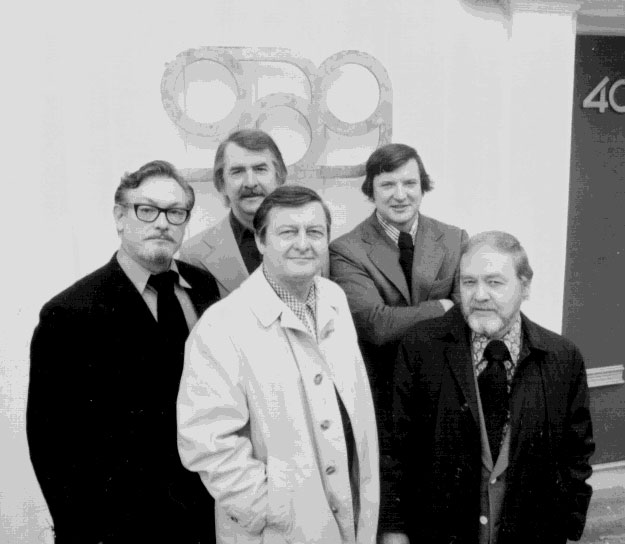
During the first couple of years after the Charter was signed, the Guild was primarily occupied with getting the word out about its existence and its stand on the various professional issues affecting its members. The group also began working on expanding the Guild’s presence into other cities—a branch was established in Cleveland in 1968, and additional branches were set up in 1970 in Minnesota and New York City. The New York Branch, founded under the leadership of Jerry McConnell and Bob Geissmann, would later prove to be crucial in the history and evolution of the Guild.
Having laid down the groundwork for a bona fide graphic artists’ labor union, the Guild’s founders decided the time had come for action. Jerry Campbell, the calligraphy/lettering artist who succeeded Marty Anderson as President of the Detroit Branch, was quoted in 1969 in the Guild’s newsletter, To Date, “We’re one year old. And most one-year-olds I know have teeth. I think it’s time we used ours and bit somebody.”
They set their sights on the Campbell Ewald advertising agency, for decades the only agency General Motors used. The reader may remember the “Like a Rock” Chevrolet TV commercials; they were one of Campbell Ewald’s creations. In the late 1960s/early 1970s, Campbell Ewald was so tight with GM, and Chevrolet in particular, that its office was actually inside of the old GM headquarters building.
The Guild tried to initiate negotiations with Campbell Ewald to gain concessions for the oppressive conditions that Campbell Ewald’s studios had its artists working under. However, the talks did not succeed in obtaining an agreement; in 1971, the Guild called a strike. It was time to use its teeth!
A large crowd of disgruntled graphic artists gathered at the Guild’s headquarters, and proceeded to the GM building to set up a picket line along the huge building’s front sidewalk. The news reporters covering the picketing artists made the observation that they had the most well-designed and visually-appealing picket signs they’d ever seen.
This first attempt at collective bargaining for artists hinted at a bright future for the profession and its practitioners. Unfortunately, they weren’t quite able to pull it off, and the strike had to be called off. According to some sources, the Guild had not gathered enough advance support for the strike within the local industry to bring Campbell Ewald back to the bargaining table. During the strike, a lot of scab artwork was done, and that, in combination with all but one of the studios “turning the screws” on the strikers to give up, caused the Guild’s strike to go down in defeat (the lone ‘good-guy’ studio was Skidmore-Sahratian).
This was a blow to the membership of the Guild’s Detroit Chapter. It never fully recovered from the failure. The resulting sense of futility and apathy caused a rapid decline of the Graphic Artists Guild in Detroit. By 1973, it came down to a final three-person Board Meeting attended by Marty Anderson, Jerry Campbell, and Fred Norton. They decided to allow the Detroit Guild to expire (its legal status was not renewed). Jerry accepted most of the Detroit Guild’s records from Marty and acted as their caretaker for many years afterwards.
Enter Jerry McConnell and the New York Chapter. They watched in dismay, while the National Office dissolved the organization they had just established a foothold for in the Big Apple. McConnell and his fellow New York Chapter members decided this was NOT going to be the end—it was too worthy a cause to let go. They carried on, acting as the ‘de facto’ National Guild headquarters in the absence of Detroit.
Things started off slowly, but Jerry and the others hung in there. The turning point came in 1976. Another New York-based group, the newly-formed (1974) Illustrators Guild, affiliated with the Graphic Artists Guild.
As a result of this mutually beneficial union, the majority of New York’s top illustrators became Graphic Artists Guild Members overnight. Most importantly, the affiliation united the Illustrators Guild’s energetic leaders, headed by Simms Taback, with Jerry McConnell and the other New York Chapter Founders. Together, they re-established an official National Guild Office in New York (with the blessing of Detroit’s Jerry Campbell). Following that, they traversed the country talking to potential new Guild chapter leaders, and they launched an unprecedented period of progress, change, and growth for the Guild, which lasted from the late 1970s through the mid-1980s.
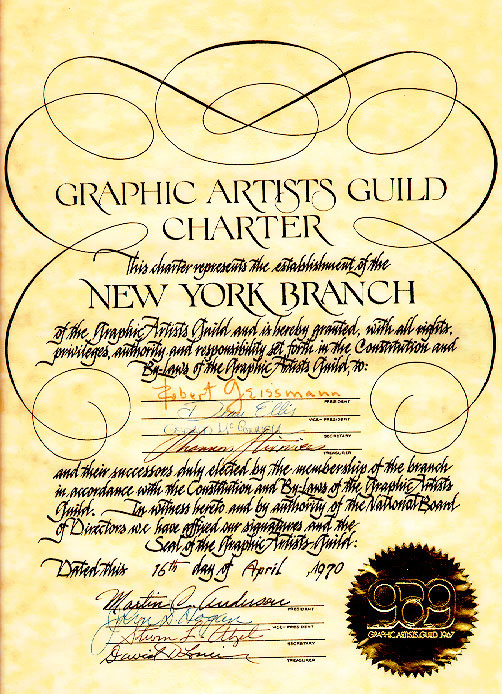
Since then, the Guild has had many successes, primarily on the advocacy and legislative fronts. And it even got back to its labor union roots in 1995, by successfully negotiating a collective-bargaining agreement on behalf of the employee artists of New York’s Channel 13/WNET PBS station. There have been ups and downs, but with solid growth and wise stewardship, there’s every reason to believe that the Guild’s ultimate potential can and will be fulfilled. Though he may not have known it when he passed away in 1987, Marty Anderson’s dream is still very much alive.

